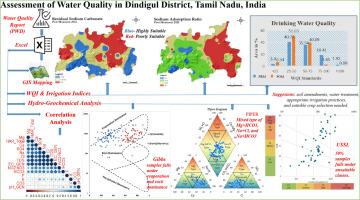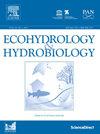A comprehensive analysis of groundwater quality: Geospatial and multivariate approaches in Dindigul District, Tamil Nadu, India
IF 2.2
4区 环境科学与生态学
Q2 ECOLOGY
引用次数: 0
Abstract
This study focuses on a comprehensive analysis of groundwater quality by integrating hydrogeochemical, geospatial, Multivariate Statistical Approaches (MSA), and water quality indices (WQI), along with visualization techniques, in the Dindigul district of Tamil Nadu, India. A total of 69 water samples, collected during pre-monsoon (PRM) and post-monsoon (POM) periods by the Public Works Department, Tharamani, were analyzed for major cations (Na+, Ca+, Mg+, K+), anions (Cl-, SO4-, HCO3-, NO3-), and various physical and chemical parameters such as pH, Total Dissolved Solids (TDS), and Electrical Conductivity (EC). The Water Quality Index (WQI) for Bureau of Indian Standard was calculated to assess water quality for drinking purposes. PRM samples showed poorer water quality due to ion dilution and agricultural influence compared to POM samples. The WQI revealed that 3.4 % of the PRM area had excellent water quality, 40.72 % good, 35.54 % poor, 18.41 % very poor, and 1.91 % unsuitable for drinking. In the POM period, 6.34 % of the area was classified as excellent, 51.03 % good, 40.09 % poor, 2.45 % very poor, and 0.08 % unsuitable. Irrigation water quality indices, including Sodium Percentage (Na%), Sodium Adsorption Ratio (SAR), Kelly's Ratio (KR), Magnesium Hazard (MH), Residual Sodium Carbonate (RSC), and Permeability Index (PI), were also computed to identify suitable zones for sustainable agriculture. Correlation analysis indicated significant positive relationships between TDS and other parameters, like Bicarbonate, Total Hardness, Chloride, and EC during PRM, and Sulphate, Total Hardness, Calcium, Chloride, Sodium, and EC during POM, suggesting that TDS is a key indicator of water quality variations in both periods.

地下水质量的综合分析:印度泰米尔纳德邦Dindigul地区的地理空间和多元方法
本研究以印度泰米尔纳德邦Dindigul地区为研究对象,利用水文地球化学、地理空间、多元统计方法(MSA)和水质指数(WQI)以及可视化技术对地下水质量进行了综合分析。泰国公共工程部在季风前(PRM)和季风后(POM)期间收集了69个水样,分析了主要阳离子(Na+, Ca+, Mg+, K+),阴离子(Cl-, SO4-, HCO3-, NO3-)以及各种物理和化学参数,如pH,总溶解固体(TDS)和电导率(EC)。印度标准局的水质指数(WQI)是用来评估饮用水水质的。与POM样品相比,由于离子稀释和农业影响,PRM样品的水质较差。水质指数显示,水质优良的占3.4%,良好的占40.72%,差的占35.54%,极差的占18.41%,不宜饮用的占1.91%。在POM期间,6.34%的地区被评为优秀,51.03%为良好,40.09%为差,2.45%为极差,0.08%为不适合。通过计算灌溉水质指标,包括钠百分比(Na%)、钠吸附比(SAR)、凯利比(KR)、镁危害(MH)、残余碳酸钠(RSC)和渗透指数(PI),确定可持续农业适宜区。相关分析表明,PRM期TDS与碳酸氢盐、总硬度、氯离子、EC、硫酸盐、总硬度、钙离子、氯离子、钠离子、EC、POM期TDS呈显著正相关,表明TDS是两个时期水质变化的关键指标。
本文章由计算机程序翻译,如有差异,请以英文原文为准。
求助全文
约1分钟内获得全文
求助全文
来源期刊

Ecohydrology & Hydrobiology
Agricultural and Biological Sciences-Aquatic Science
CiteScore
5.40
自引率
3.80%
发文量
51
期刊介绍:
Ecohydrology & Hydrobiology is an international journal that aims to advance ecohydrology as the study of the interplay between ecological and hydrological processes from molecular to river basin scales, and to promote its implementation as an integrative management tool to harmonize societal needs with biosphere potential.
 求助内容:
求助内容: 应助结果提醒方式:
应助结果提醒方式:


